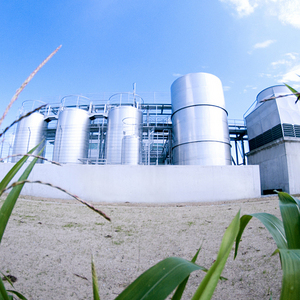Clariant demonstrates Sunliquid process with stover, bagasse

Clariant/Rötzer
June 5, 2013
BY Susanne Retka Schill
Not quite a year after opening a demonstration facility, Switzerland-based specialty chemicals company Clariant AG announced that it has expanded the feedstocks successfully converted to cellulosic ethanol beyond wheat straw to include corn stover and sugarcane bagasse.
“Expanding the technology to other raw materials represents an important milestone in the commercialization of our Sunliquid process, extending it far beyond European borders,” explains Hariolf Kottmann, CEO. “In doing so, we are demonstrating that the process is flexible for different raw materials, and can therefore also be used in key markets such as North America, Latin America and Asia.” The high degree of efficiency of the process, independent of the raw material used, is achieved largely through the use of raw material-specific, highly-optimized enzymes.
Clariant began operating its demonstration-scale cellulosic ethanol plant in Straubing, Germany, last July. http://ethanolproducer.com/articles/8973/sunliquid-cellulose-ethanol-process-reaches-demo-scale-in-germany With an annual capacity of up to 1,000 tons (330,000 MMgy), the demo plant scales up the pilot-scale work done by Sud-Chemie in 2009 at its research headquarters in Munich. Clariant, which acquired Sud-Chemie in 2011, says the demonstration project represents an investment of about EUR28 million ($36 million).
Advertisement
Advertisement
Clariant intends to market the Sunliquid process internationally – making it vital that different raw materials can be flexibly and effectively used in the process, the company said. Corn stover is primarily important in North America, where 570 million tons are left after the corn harvest every year. In Brazil, ethanol production could be increased by some 50 percent compared to current levels by using excess bagasse.
Using these plant residues means that there is no competition with food production or for agricultural land. Cellulosic ethanol produced using the Sunliquid process reduces greenhouse gas emissions by around 95 percent compared to fossil fuels. Domestic production of this liquid fuel can also reduce dependence on oil imports and generate economic growth in local markets.
Advertisement
Advertisement
The next step in commercializing the technology is the construction of the first commercial production facility, with a target capacity of some 50,000 to 150,000 tons per year.
“In Sunliquid, we have a mature technology that we now want to apply worldwide,” said Markus Rarbach, head of start-up business biofuels and derivatives. “We are currently assessing potential partners and locations for the first production facility. Our business model ultimately comprises issuing license packages for the full process.” Rarbach adds that long-term secure and stable political conditions are also an important requirement in order for a project like this to achieve its entire potential.
Related Stories
The U.S. exported 31,160.5 metric tons of biodiesel and biodiesel blends of B30 and greater in May, according to data released by the USDA Foreign Agricultural Service on July 3. Biodiesel imports were 2,226.2 metric tons for the month.
CARB on June 27 announced amendments to the state’s LCFS regulations will take effect beginning on July 1. The amended regulations were approved by the agency in November 2024, but implementation was delayed due to regulatory clarity issues.
Legislation introduced in the California Senate on June 23 aims to cap the price of Low Carbon Fuel Standard credits as part of a larger effort to overhaul the state’s fuel regulations and mitigate rising gas prices.
The government of Brazil on June 25 announced it will increase the mandatory blend of ethanol in gasoline from 27% to 30% and the mandatory blend of biodiesel in diesel from 14% to 15%, effective Aug. 1.
FutureFuel idles biodiesel production amidst regulatory uncertainty, shifts full focus to specialty chemicals growth
FutureFuel Corp. on June 17 announced it will temporarily idle its biodiesel facility upon completion of its remaining contractual obligations, anticipated to occur by the end of June. The company is shifting its focus to specialty chemicals.
Upcoming Events









